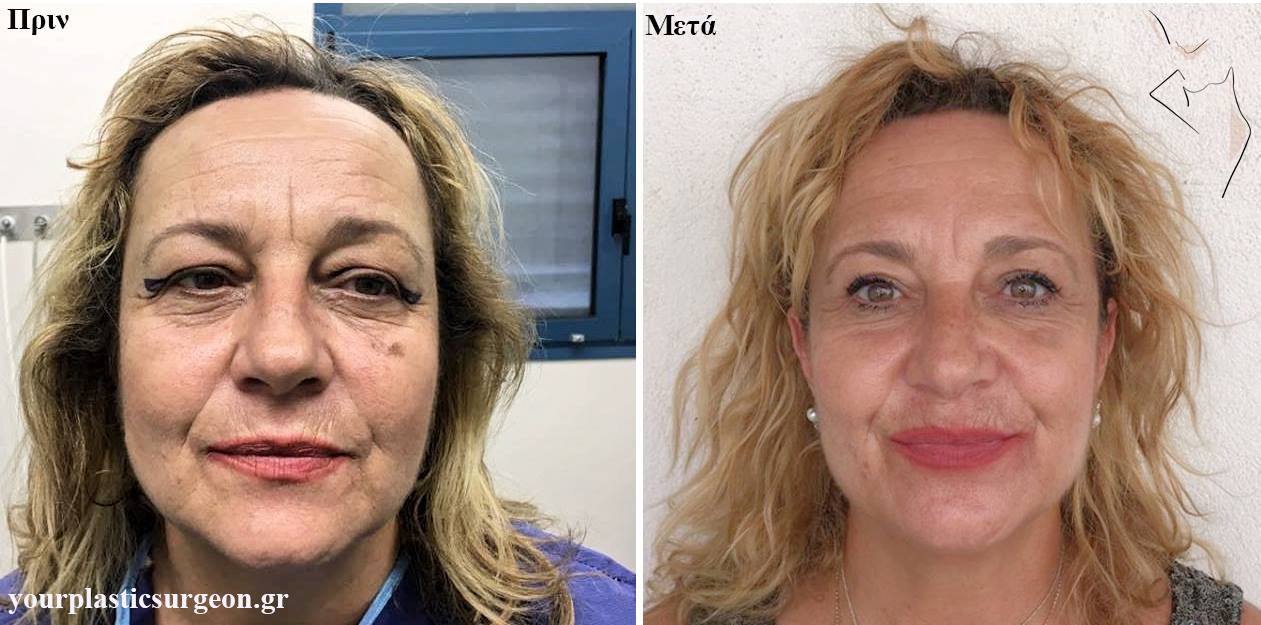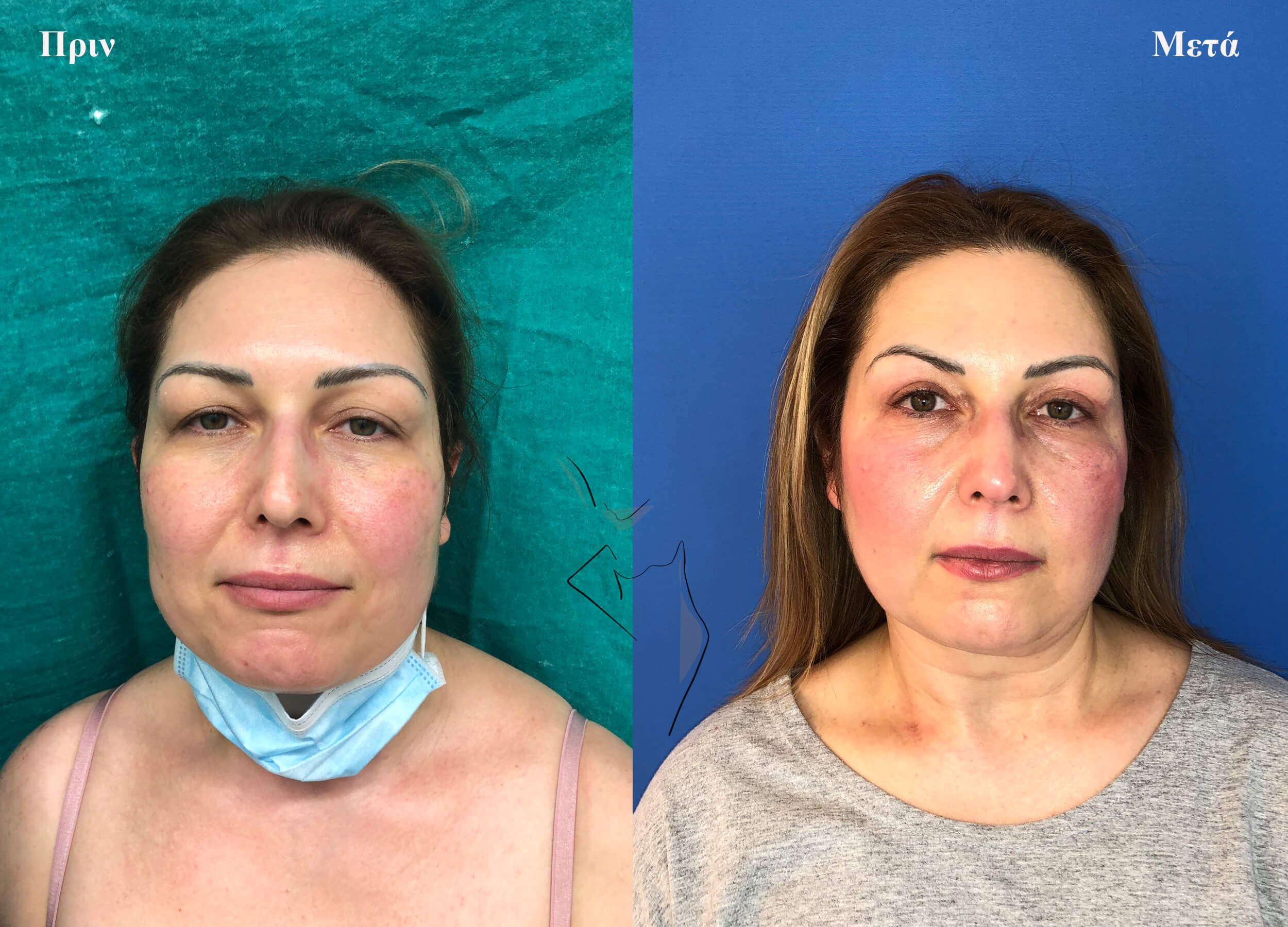Men or women at any age with droopy, hooded upper lids or puffy under-eye bags who wish to have a youthful and attractive appearance of their eyes. People with hooded or ptotic upper lids may have obstructed visual fields that is corrected during blepharoplasty.

Blepharoplasty
Ideal candidates
The procedure
Upper blepharoplasty: Skin incision is placed in the natural crease of the eyelids to remove excess skin and fat, while orbicularis oculi muscle is typically spared. Fat is also minimally removed to avoid a “hollow-eyes” appearance. Lateral canthus is elevated with non-absorbable sutures, as it normally lies 2mm higher than medial canthus. Lower blepharoplasty: Skin incision is placed 2mm under the lower lid margin to remove excess skin and fat that cause tiring and saggy appearance. In almost every patient over 40 years, tightening of the lower lid must be performed to avoid scleral show.
Anesthesia
Local anesthesia. The procedure is completely painless
Recovery
Swelling and Bruising: Swelling and bruising are common in the first few days after surgery. Applying ice packs is recommended to reduce swelling and bruising. Suture Removal: Stitches are usually removed on the 5th to 7th day after the surgery.You can return to work after this period. Eye Care: Use eye drops as prescribed because dryness of the eyes is common after blepharoplasty and can last for up to a month. Scar Care: Apply a regenerative cream to the scars and use sun protection to ensure that the scars become barely visible after 3-4 months.

Upper blepharoplasty with local anesthesia to restore laxity and correct drooping of the left eyelid with puckering of the levator muscle.

CONTACT
Wish to learn more? Contact the doctor here:
Frequently Asked Questions about Blepharoplasty
What is Upper Blepharoplasty?
Upper blepharoplasty is a cosmetic surgical procedure that aims to remove excess skin and fat from the upper eyelids to reduce the feeling of puffiness of the eyelids.
What is the surgical goal of upper eyelid surgery?
During the procedure we make small incisions along the natural crease of the upper eyelid, which is typically located 8 millimeters above the eyelashes. Through these incisions, the excess skin and fat are removed. The incisions are then closed with fine sutures.
What are the benefits of upper blepharoplasty?
The benefits include a more fresh and relaxed appearance of the eyes, and also improved vision if the sagging skin affects the visual field. Blepharoplasty has been shown to improve someone’s self-confidence and quality of life.
Are there any risks or complications in upper blepharoplasty?
As with any surgical procedure, upper blepharoplasty can rarely have complications. Your plastic surgeon must make precise measurements and tests before the operation to remove the appropriate amount of skin for a harmonious result. With the correct surgical technique and your compliance with their instructions, you reduce the chances of the wound infection, bleeding, or developing a disfigured scar.
Is there anything I should be aware of before the operation?
It is recommended to stop smoking 2 weeks before and 2 weeks after the operation. Also, avoid taking aspirin and other anticoagulant medications, as they can increase bruising or even cause retrobulbar hematoma. Your plastic surgeon will give you written instructions to prepare you for what is required after the operation.
What is the difference between lower blepharoplasty and upper blepharoplasty?
Lower blepharoplasty is a cosmetic surgical procedure aimed at improving the appearance of the lower eyelids. Specifically, it addresses issues such as bags under the eyes, skin laxity, and dark circles. This procedure can help create a more youthful and rested appearance. If there is skin laxity in the lower eyelids, the procedure is done through small incisions under the eyelashes, while if the skin is firm and there are only bags, the procedure is done through the conjunctiva. While upper blepharoplasty also aims to improve the visual field as the upper eyelid is the mobile one, lower blepharoplasty focuses solely on improving someone’s appearance.
How long is the recovery from blepharoplasty?
Recovery typically lasts an average of 4 days. Periorbital swelling and bruising are common in the first few days after the operation but usually subside quickly. Most patients return to their daily activities after 1 week when the sutures are removed.
How long do the results last?
Although the aging process does not stop, the results of blepharoplasty are long-lasting, typically 10-15 years.
How much does upper blepharoplasty cost?
The cost of the operation can vary depending on the surgeon you choose and the complexity of the problem of your eyelids. The operation is usually performed under local anesthesia, so there is no anesthesiologist cost; however, if one chooses to undergo sedation for the procedure, the cost increases. During the first consultation at the surgeon’s office, you will be thoroughly informed about the cost.
Who is the right surgeon for blepharoplasty?
It is essential to choose a board-certified plastic surgeon with experience in blepharoplasty. Often, it is not just about removing skin and fat from the upper eyelids but also restoring the lift mechanism of the upper eyelids. Your plastic surgeon should have the knowledge to recognize this need and address it. Additionally, they should be meticulous with details, as the key to the ideal blepharoplasty result is careful preoperative planning.
Is non-surgical blepharoplasty effective?
Using lasers, radio frequencies, or plasma technology (Plexr) is an alternative for those who do not wish to undergo traditional surgical blepharoplasty. However, it is important to be aware of the limitations of this method:
These devices cannot address the issue of ptosis, which requires surgical intervention by a specialized surgeon to restore the lift mechanism of the upper lid. Additionally, multiple sessions are usually needed to see a significant result, and it is indicated for limited degrees of laxity in the eyelids.
